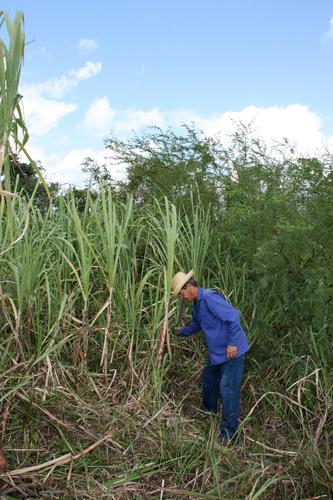What is Nicotine-Free Tobacco?
Nicotine-free tobacco generally refers to tobacco made with substitute materials. These substitutes can vary, but tobacco replacements often resemble traditional tobacco in appearance while containing little to no nicotine. The usage is also similar: nicotine-free tobacco can, for example, be smoked in a pipe or as a cigarette. Smokers often turn to nicotine-free tobacco to help quit smoking.
You may already know that traditional tobacco is made from the leaves of the tobacco plant, which naturally contains nicotine. Tobacco without substitutes can be obtained in two ways:
-
Either by extracting the nicotine from the tobacco leaves
-
or by successfully cultivating genuinely nicotine-free tobacco.
In the past, there were successful efforts in Argentina and Germany to produce nicotine-free tobacco using modern genetic engineering. However, these solutions are not legal in Germany.

Production and Extraction of Nicotine-Free Tobacco
Commercially available nicotine-free tobacco is often derived from herbs (e.g., Knaster), sugarcane, or hemp. Herbal cigarettes made from Knaster are among the best-known tobacco substitute products, particularly as a brand is named after it. These cigarettes are nicotine-free and contain significantly less tar than traditional cigarettes. Originally, Knaster was a herbal blend used to freshen room air. Smokable herbs include lavender, marshmallow, chamomile, damiana, sage, or green tea.
Technically, all substitutes are not classified as tobacco by law but are treated legally and for tax purposes as such. In colloquial language, it has become standard to refer to all substitutes for tobacco products as tobacco.
Tobacco Substitutes: Other Forms
Nicotine-free tobacco substitutes are used in various ways, especially with the rise of e-cigarettes.
-
Cigarettes or tobacco with herbs (e.g., Knaster) – Tobacco substitutes with herb-like ingredients in cigarette form, for pipe smoking, or for rolling your own, now also available in various flavors.
-
Herbal mixtures for hookahs (water pipes) and vaporizers – Often flavored with fruits like apple, melon, mango, or pineapple.
-
E-cigarettes with nicotine-free liquids – E-cigarettes for inhaling vapor are available with nicotine-free liquids in various flavors.
-
Nicotine-free snus – Snus is a smokeless tobacco product placed under the lip. It is also available without nicotine but faces criticism, like traditional snus, for potentially causing dental damage over time.
-
Chewing tobacco without nicotine – In addition to traditional chewing tobacco, there is also a nicotine-free version, usually made from plant fibers.
Cultivation of Nicotine-Free Tobacco
Several attempts have been made to cultivate nicotine-free tobacco, for instance, for pipe tobacco, but so far, with only moderate success. Tobaccos from popular brands like Mac Baren or Samuel Gawith pipe tobacco still contain nicotine.
In the 1930s, efforts were made in Germany to produce nicotine-free tobacco by breeding low-nicotine plants. However, the resulting blends lacked flavor and gained few followers. More recently, genetic manipulation in Argentina successfully produced nearly nicotine-free tobacco plants. Products made from this tobacco (mainly cigarettes) are sold in the United States. A few years ago, nicotine-free tobacco was also cultivated in Germany, but it was not legalized.
Nicotine-Free Pipe Tobacco
You can also smoke nicotine-free (herbal) tobacco in a pipe as usual. Here, too, it applies: Choose a pipe based on your preferences to enhance your smoking experience. Pipes made from materials like glass, ceramic, or plastic are generally recommended for nicotine-free tobacco, as they are easier to clean. This is particularly beneficial because nicotine-free tobacco can leave residues or be sticky, depending on its ingredients. When smoking tobacco substitutes in a pipe, keep the following in mind:
-
Packing and lighting the pipe requires some practice; nicotine-free tobacco demands even more finesse. Light the herbs gently and evenly.
-
Experiment with different herbal blends. They vary not only in taste but also in their effects. Chamomile, for example, is relaxing, damiana is stimulating, and mint is invigorating.
-
Ensure no tobacco residue remains in the pipe bowl. Re-lighting a cooled pipe can lead to an unpleasant taste – this applies to traditional tobacco as well.
Advantages and Disadvantages
Smoking nicotine-free tobacco is naturally much healthier and is suitable for smokers looking to quit. However, alongside its benefits, there are some drawbacks to consider:
| Advantages | Disadvantages |
| You consume no harmful nicotine: Nicotine-free tobacco is an appealing alternative for anyone wanting to quit smoking. | You may find it hard to quit smoking: You continue the smoking ritual as usual. If you are using nicotine-free tobacco to quit smoking, it is advisable to gradually reduce your consumption. |
| You can continue to smoke socially: Whether at a party or during a shared pipe session, you don’t have to miss out on social gatherings. | You could have allergic reactions to certain herbs or ingredients. |
| Numerous options: Nicotine-free tobacco or smoking offers a wide range of flavors and effects. |
How Harmful Is Tobacco Without Nicotine?
Nicotine-free tobacco or herbal blends are significantly less harmful to health than traditional tobacco or cigarettes. Tobacco substitutes largely avoid harmful substances. However, you should still check whether additives are included in the tobacco you choose.
The combustion gases (including carbon monoxide and carbonyls) that are inhaled remain harmful, as they are produced by burning any plant-based substance. However, they are far less dangerous than nicotine-containing tobacco. It is also worth considering the psychological aspect: Most smokers want to quit smoking with the help of tobacco substitutes. Nicotine-free tobacco is suitable for this purpose, but after some time, it is important to quit entirely – otherwise, the smoking habit may persist.






